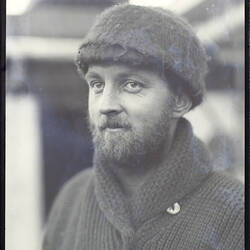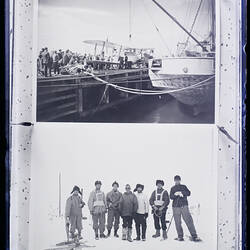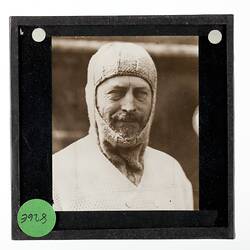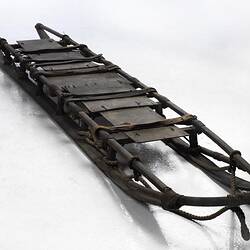Summary
Lantern slide of the de Havilland DH60G Gipsy Mothh, aboard the ship Discovery, Antarctica.
One of 328 images in various formats including artworks, photographs, glass negatives and lantern slides.
Description of Content
Royal Australian Air Force (RAAF) pilots Pilot Officer Eric Douglas - left and Flying Officer Stuart Campbell - right, standing alongside de Havilland DH60G Gipsy Moth VH-ULD, on board the ship Discovery. The Gipsy Moth was a new aeroplane built by de Havilland in England and it was crated on the Discovery to Cape Town and then to the Antarctic. When conditions were nearly suitable for flying it was uncrated and assembled by the RAAF pilots on the deck of the ship. Its storage place was normally for a whaleboat or lifeboat which was taken off the ship to make room for the aeroplane. On this voyage the whaleboat was taken off at Kerguelen Island and collected on the return journey, which meant of course that the Gipsy Moth was re-crated. The moth was flown as a float seaplane on the BANZARE Voyages. As well as the floats, skis had been made for the aeroplane and they were stored in the floats. Photograph taken during the British Australian New Zealand Antarctic Research Expedition (BANZARE), Voyage 1.
Physical Description
Standard format lantern slide, consisting of two glass sheets each 3.25 x 3.25 ins (83 x 83mm), one pane bearing a positive transparent image and the other pane protecting the image. Sealed with paper binding strips around the four edges of the lantern slide and internally framed with a black cut-out window mask.
More Information
-
Collection Names
-
Collecting Areas
-
Acquisition Information
Donation from Sally Douglas, 10 Oct 2008
-
Place & Date Depicted
Proclamation Island, Enderby Land, British Antarctic Territory, Antarctica, 1929-1930
-
Photographer
-
Expedition Leader
-
Ship Depicted
Discovery (Sailing vessel and steamship), Antarctica, 1929-1930
-
Aircraft Depicted
Aircraft, de Havilland DH60X Gipsy Moth, Antarctica, 1929-1930
-
Individuals Identified
Douglas, Eric; Campbell, Stuart
-
Format
Lantern Slide, Standard (3¼ in. x 3¼ in.), Monochrome
-
Language
English
-
Classification
-
Category
-
Discipline
-
Type of item
-
Image Dimensions - Mount
82 mm (Width), 82 mm (Height)
-
References
[Article] Douglas, Sally. Eric Douglas Antarctica Collection at Museum Victoria.
-
Keywords





